Some late reports remain from the end of February. On the 28th GK from Bentley in Hampshire fished with a friend at How Caple Court. They caught 11 chub to 5 pounds 10 ounces from the flooding Wye and by the way recorded their appreciation of overnight staying at the Annexe Cottage at Hole in the Wall, and eating at No 3 and Avellino restaurants in Ross. It’s a timely reminder of the benefit to the local economy of these angling trips. CH from Bridport in Dorset caught 6 chub to 4 pounds 2 ounces at Strangford. MA from Bridgwater caught 4 barbel to 8 pounds 4 ounces and 6 chub to 4 pounds 10 ounces at Middle Hill Court. PK from Bromsgrove blanked for grayling at Lyepole and had a strange complaint about the fencing between fields and the River Lugg which he thought should be made of plain wire. Yes of course the wire is there to keep livestock out of the river (these are farms as well as fisheries) and if it was all plain wire rather than barbed wire, the beasts would push it down. Hence along with the barbed wire there is that need for stiles, plastic wire covers and even, when push comes to shove, an effort from anglers to wriggle under the lower wire to get past (take the net off your back first). It is certainly fair to comment that many of the stiles and crossing points at Lyepole currently need repair and revision.
The 3rd and our opening for trout and salmon was a truly lovely day, cold and sharp with a clear blue sky. Unfortunately the hills around were covered with the snow which had fallen on the previous afternoon and the rivers were still very high. Most salmon anglers were washed off. MR from Narbeth struggled with the high water at Ashford House, but caught 5 trout between 12 and 14 inches on nymphs. AL from London was upstream at Dinas and caught 4 trout while some large dark olives and March browns were hatching. Several canoes passed through the beat while he fished. Unfortunately the Brecon gauge was then out of order so that the record could not be viewed online. Clearly the level must have been high, but if the level on the gauge was below the red line at the time, these paddlers would indeed have trespassing.
A return to cold wintry weather in March after that remarkably warm February began to have its effect. CM from Keynsham who has successfully fished his way for barbel and chub through the winter encountered frost and then cold rain on the 4th at How Caple court. He measured the water temperature at 5.8 degrees, comparing with 10 degrees the previous week, and struggled to take a couple of chub. Early trout anglers complained about a lack of fly, which was not really surprising given the temperature trends. AL from London had problems with access on the Usk at Upper Tower due to high water and flood debris. Instead he moved to Abercynrig where despite the high water he managed 4 trout on nymphs and spiders. On the 5th BW from Stratford on Avon was another who complained about the bank access arrangements at Lyepole. He managed 2 trout on heavy nymphing methods from the bank, but at 0.75 metres on the Byton level gauge found the Lugg impossible to wade. Personally I would regard anything over 0.50 as a flood. MS from Gwynfe took 4 trout at Penpont, three on nymphs and one on a dry sedge pattern. He reported a weak hatch of March browns and, rather surprisingly this early, blue winged olives.
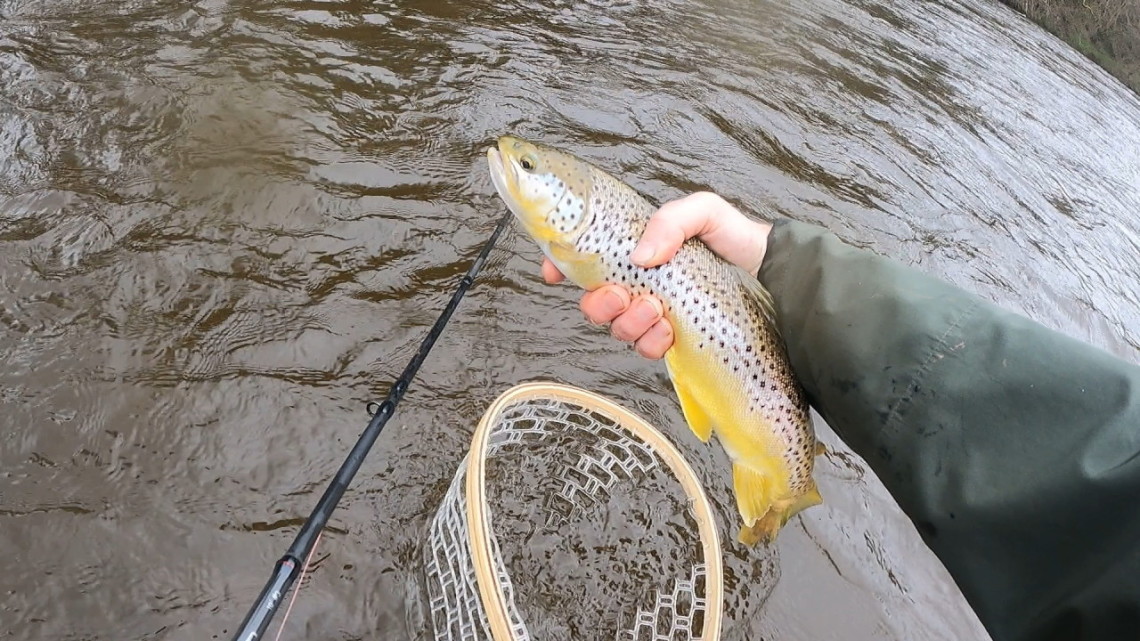 Buckland - KL from Chilbolton
Buckland - KL from Chilbolton David Burren and I had a session on the Usk at Brecon on the 7th. About the middle of a cold, dark day with the river very high and turbulent and a strong east wind, I fished down a favourite pool with a team of spiders. The river had quite a push to it and I pulled a back muscle trying to keep my footing amidst large boulders. These conditions should be expected at the beginning of the season and yet the pool was strangely quiet. No fly at all was visible on the surface although I saw just one rather explosive natural rise, although at what I was not sure. I had one pluck from a fish which didn’t hang on. Then, towards the bottom of the pool and looking into the light, I suddenly glimpsed the silhouette of a long black shape rolling through the rippled surface not far below the position of my flies. What! Could salmon be up here already? Mentally I braced myself for a heavy take – salmon often do take spiders - and then after a couple of seconds realised that, of course, it was not a salmon. It couldn’t possibly be. It was an otter fishing the flood, in fact a whole family of otters, and in a little while they came slipping up past me under the willow shoots of the far bank.
So much for that pool, which the otters had probably been working all morning. I retreated round the corner where the wind was a little less and where I joined David who was concentrating on a fast, smooth pool tail. Just the occasional olive dun came drifting down from above and just the occasional small trout rose. Spiders weren’t working for me on this day, so I joined David by changing to a dry fly. It was hard work, but we managed 3 handsome little brown trout of about 10 or 11 inches with flies like Goddard’s Emerger and an Olive Jingler. Both David and I are old school enough to like the idea of taking the first trout of the season on a dry fly. By 3 o’clock with the wind increasing again and the temperature dropping rapidly it was clearly over.
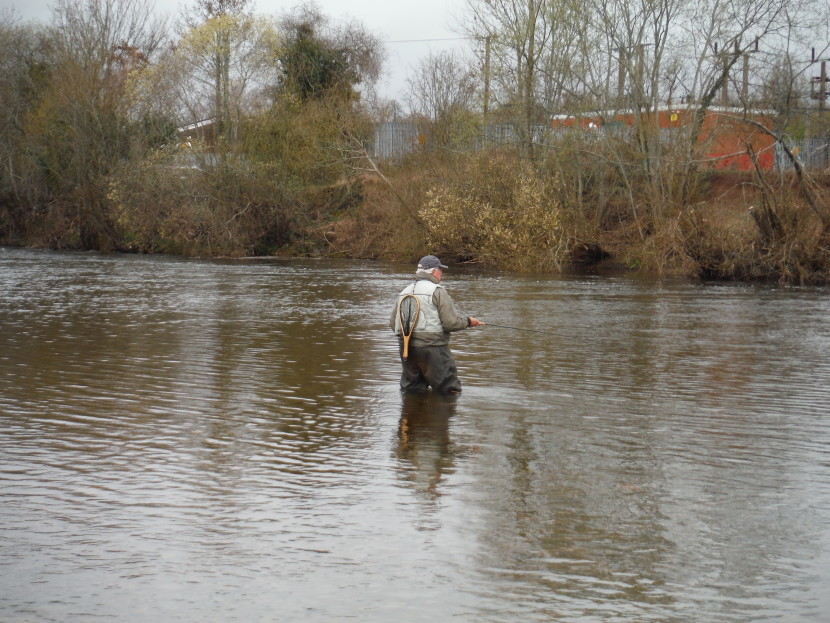 Early season at Brecon
Early season at Brecon 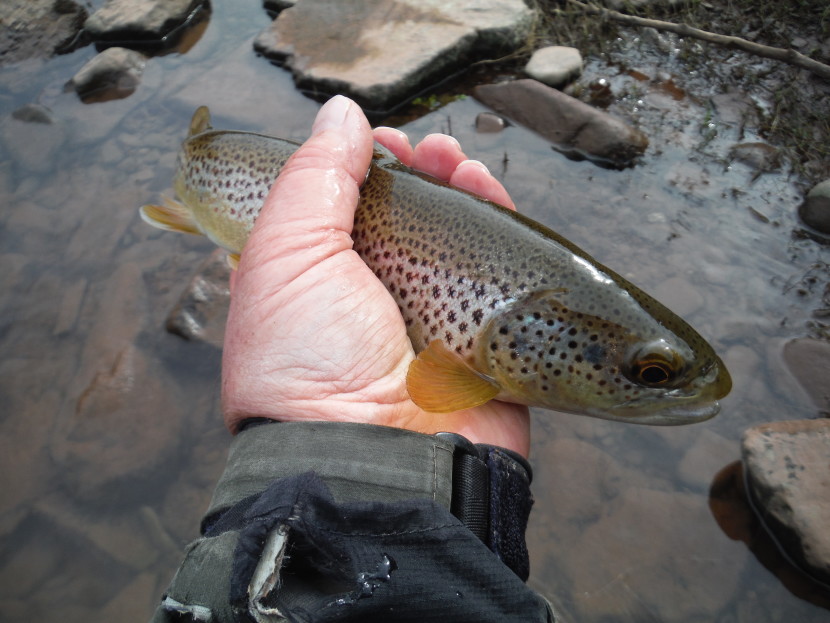 First of the season
First of the season Next day I had just a couple of hours to spare, which I spent on our Forest Pool. It was still quite cold, but the thick stands of trees had taken the sting out of the east wind. The brown flood colour had now gone from the water of the pool leaving it a clear green. And to my surprise, the rainbow trout were very active on the surface, rising with explosive rings to something they were chasing up through the water column. This would surely be a day for the floating line. The hatch turned out to be one of grey boy midges, some of them with bodies nearly half an inch long, and by lunchtime I had returned 9 fish using a little grey Hatching Midge pattern on a long leader.
Given the admittedly artificial nature of fishing for rainbow trout, bred on Exmoor and stocked here in the Forest of Dean, the early spring gives some of the best of it, particularly as the buzzers begin to hatch. A week later the same midges were still hatching, but now the trout were following the pupae up to the surface rather than taking adults. A size 14 quill-bodied superglue buzzer just cast out and allowed to sink in its own time provoked some very solid takes.
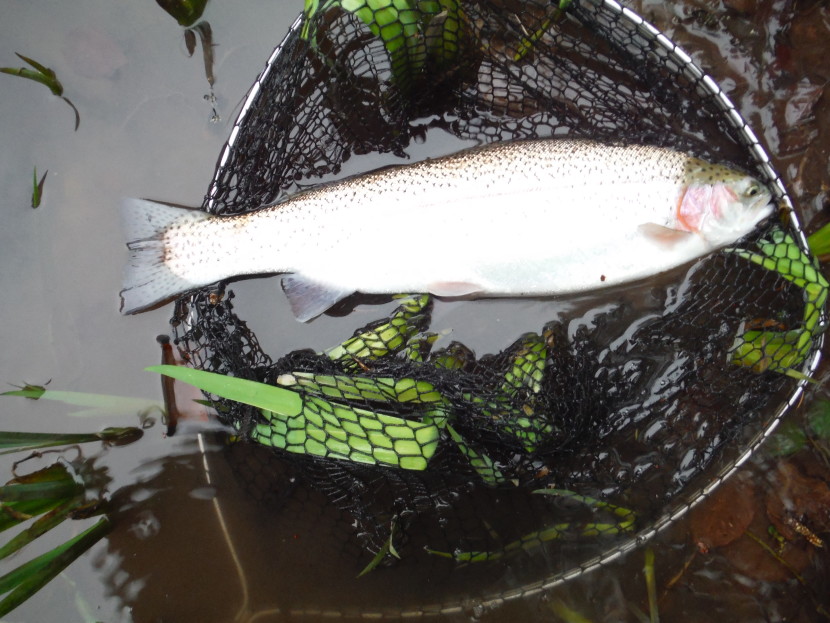 Overwintered rainbow
Overwintered rainbow 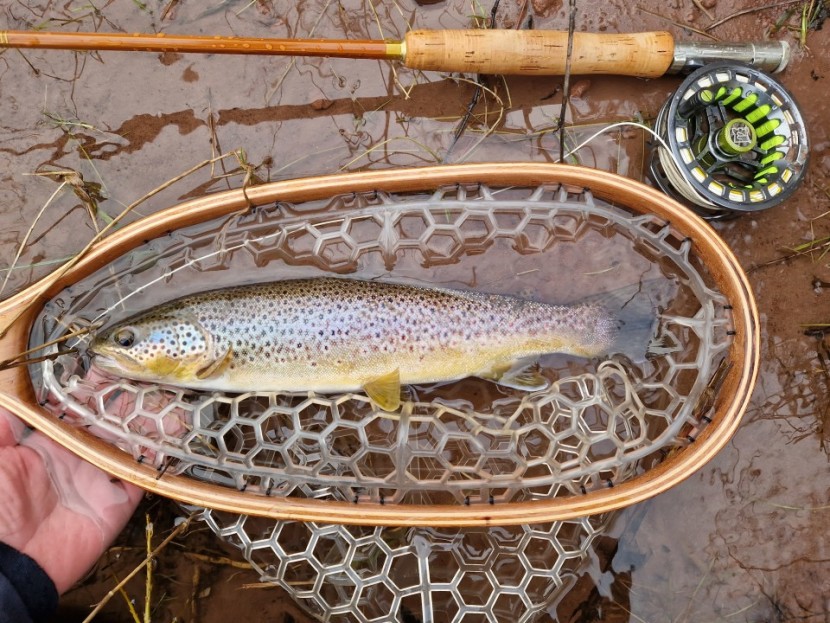 Upper Tower - BG from Exeter
Upper Tower - BG from Exeter Meanwhile on the Wye AG from Hoddesdon led a party of 4 anglers over three days divided between Middle Hill Court and the Creel, and reported good catches of barbel and chub. DG from Pontypridd with three friends fished Middle Hill Court on the 8th and reported 31 chub, 1 barbel and a couple of grayling. The last species has been turning up quite regularly at Middle Hill Court this season. JS from Aberdare lost a salmon hooked on Beat 4 of Whitney Court at 9 o’clock in the morning. Sadly, this was the only take of the day.
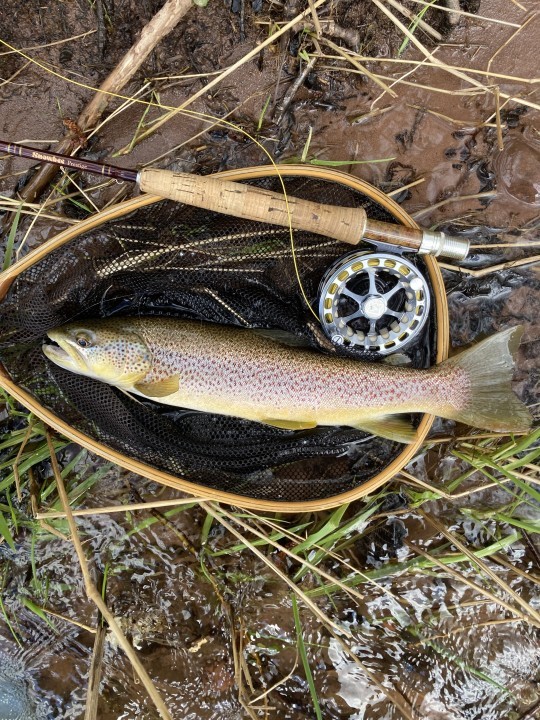 Breconshire - AT from Cobham
Breconshire - AT from Cobham TS from Haverford West with 2 friends was fishing upstream at the Rectory and they returned one well mended kelt and 4 chub. CP from Clevedon was at Llangoed for salmon and managed to fish all the way down the ledges from the rapids through Chapel Catch to the waterworks – but no cigar! JL from London with two friends were on the Usk at Penpont and took 11 trout with the dry fly during middle of the day hatches. Joe Alexander from Rhayader was out on the little Edw tributary’s lowest beat at Aberedw and caught 5 trout on nymphs and streamers. PD from London had a 2 pounds trout from a rising Usk at Cefn Rhosan Fawr on a Black Woolly Bugger streamer.
The 11th saw a return to rain and it was surprising how our rivers, which had been dropping very slowly and with seeming reluctance over many days, quickly rose back into dirty flood. In addition, this was a time of high spring tides. The largest bore due for this year came up the Severn which flooded back up into Worcestershire and we were warned of road flooding on the tidal section of the Wye as far up as Redbrook. One man who would have appreciated this was the embarrassed Bristol Channel pilot in charge of the EEMS Servant motor vessel from Santander in Spain. This 100 metre vessel had been stranded on estuary sands since the 4th, having misjudged the turn to get into Sharpness docks. It was thought that the heavy floods of the past winter had expanded the sand banks into the navigation channel. A tug having failed to move her, the Servant sat high and dry waiting for bigger tides. There is a long history of such accidents in this part of the estuary and ships as large as 6,000 tons have been lost. In this case the crew and pilot stayed on and, sure enough, with the help of another tug and higher water with the spring tides, she was safely in dock by the end of the week.
Air temperatures at least were higher now. However, the rain continued day after day and the sun was rarely seen. This particularly sodden week was no fun for any of us, but at the time I particularly felt for our daughter who was running around Staffordshire on a section attack exercise. Unluckily for her, I thought in sympathy. Soldiers will know that these career critical exercises have to be undergone on occasion, but they will also tell you that if you really have to spend a week sleeping out, much better to do it in a frost than in continuous rain. Dug in under a poncho stretched low between a couple of trees only gives so much protection and Medina tells me that if you get to sleep at all there is always that dreaded two in the morning call to go and lie out on stag position, watching and listening for a hostile incursion. Tabbing along with the rifle, webbing, helmet and a 35 kg bergen is almost pleasantly warm by comparison, even for a slightly built nurse weighing 59 kg. Who claims our Army isn’t fit; the infantry part of it have to do these all the time? Everybody was exhausted on the bus back to camp and the waiting hot showers.
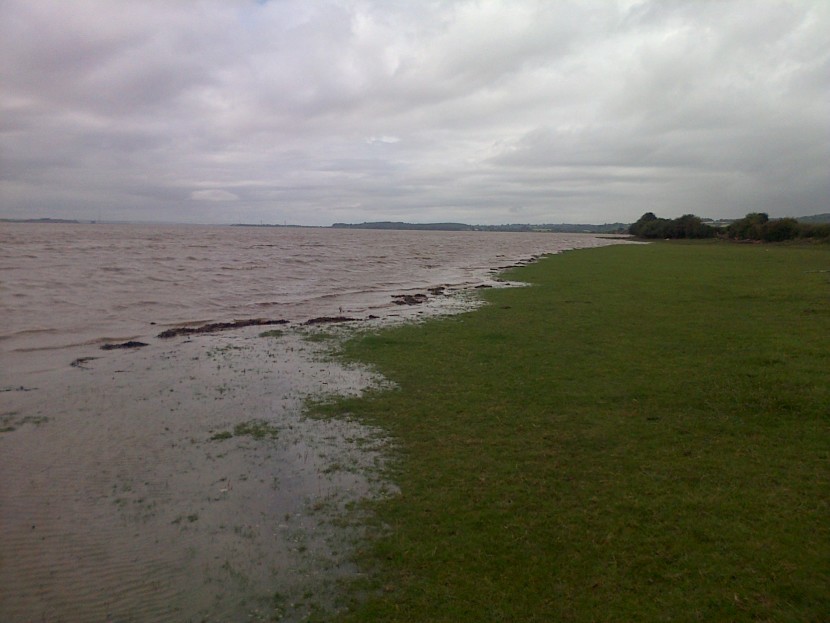 Spring tide on the estuary
Spring tide on the estuary 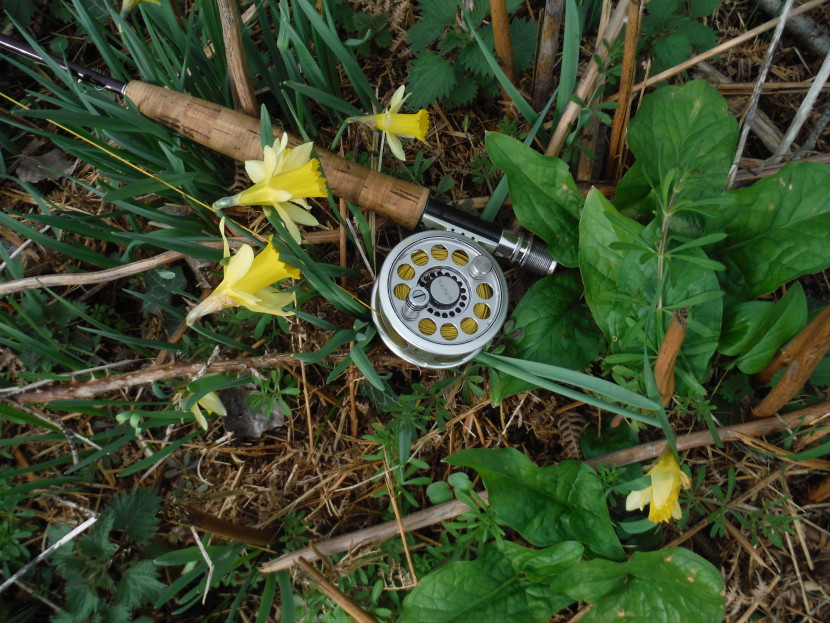 Spring on the wild streams
Spring on the wild streams There followed a long gap in game fishing reports due to the state of the rivers. Coarse anglers pressed on with the flooded Wye in the final days of their season. The water temperature was now back up at around 10 degrees, which would have been helpful to them. CM from Ware with a friend fished at Lower Canon Bridge and reported 6 barbel to 9 pounds 14 ounces and 22 chub to 5 pounds 10 ounces. A great day indeed! HT from Aylesbury with a friend were at How Caple Court and recorded 8 barbel, all of them large fish over 6 pounds and the best at 8 pounds 12 ounces, plus a chub of 4 pounds. CM from Ware with a companion recorded 3 barbel to 10 pounds 4 ounces and 4 chub to 5 pounds 1 ounce at Middle Ballingham and Fownhope No 5. GL from Abergavenny took 7 chub at Upper Breinton. CM from Keynsham with 3 friends fished at Middle Hill Court and recorded 10 barbel to 8 pounds, plus a chub, dace, gudgeon and eel. CW from Swindon and a friend shared 8 chub, a barbel and a grayling while fishing at Foy Bridge. Meanwhile MB from Worthing with two friends had a problem with a Severn / Trent Water official about the parking at the top end of the Courtfield beat. The water company have an uptake here which pumps Wye water up to a tank at Wigpool, from which, after treatment, it is distributed all over the Forest of Dean and more widely still. I do believe it supplies our house. The WUF has confirmed that by agreement anglers on the Courtfield beat may park beside the water company entrance, provided they do not obstruct it. MB’s group caught 2 barbel and a chub.
With the rivers all in flood, there was quite a rush from the towns of South Wales to the upland reservoirs during the weekend of 16th and 17th March. Most anglers on Llwyn On seem to have caught one or two. The Usk Reservoir performed well: NT from Carmarthen with two friends recorded 18 trout, YA from Mountain Ash had 6, and GJ from Ammanford also had half a dozen on black and olive lures.
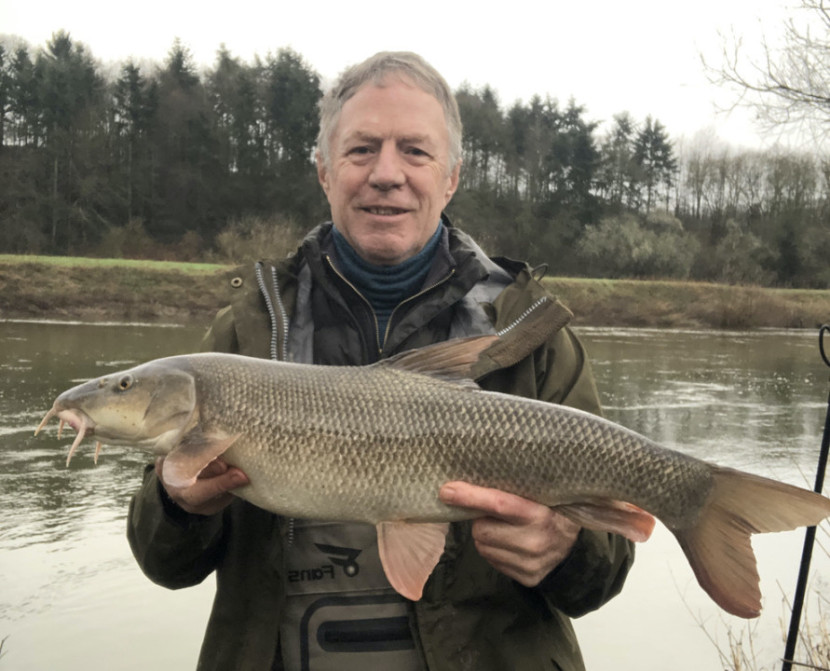 How Caple Court - GK from Bentley
How Caple Court - GK from Bentley 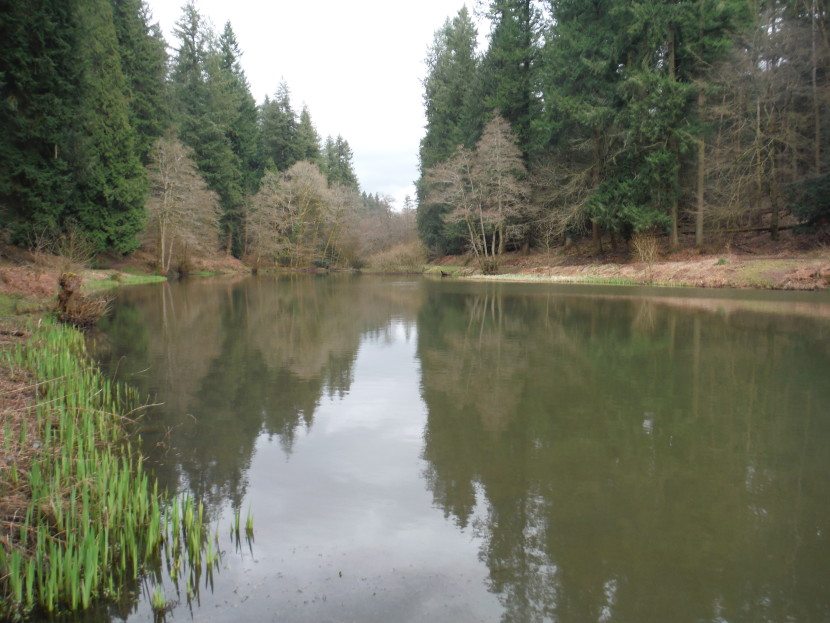 Forest Pool in early spring
Forest Pool in early spring RB from Redditch did very well to get 7 trout from a flooding Usk at Dinas on the 17th. PT from Kingstone rode a motor cycle right up to the top of the Wye at Ty Mawr and, despite getting himself soaked, caught a 15 inch trout on a Pheasant Tail Nymph. By the 20th the rivers began very slowly to drop again. GM from Shrewsbury recorded 7 trout from the Usk at Cefn Rhosan Fawr while KT from Chilbolton had a specimen 2 pounder from the new beat at Buckland. DJ from Halesowen with a friend managed 9 trout on nymphs from a “very full” Usk at Dinas and noted with gratitude that the landowner has moved the entrance gate downhill from its original position on a steep slope. (However, so wet was this month and the fields so full of water, that at Dinas it was generally wiser to park uphill at the side of the entrance road from the layby. I learned this the hard way). On the 21st the Usk gauge at Brecon was showing 1ft 4 inches. RG from Freshford saw no rises at Abercynrig, but he managed 7 trout by fishing spiders down and across the stream.
JT from Stockport was at Upper Tower with a friend and they caught half a dozen on dry flies. There was a sparse hatch of large dark olives and March browns after lunch. JB from Bedford with a friend got 10 trout between them from Ashford House, but no hatches were to be seen and the fish were taken with upstream nymph: “Weather horrific. Downstream wind, rain and hail storm.” SH from London with a friend had 8 trout to an impressive 19 inches from Cefn Rhosan Fawr. A few large dark olives were hatching, but there were no rises. BJ from Pontyclun took 5 trout on nymphs from the Breconshire Fishery. Again, large dark olives were in evidence, but no rises. MB from Abergavenny with a friend had 6 trout on Cwmwysg Ganol using nymphs and wondered why so much barbed wire is strewn around the gates, thus making access difficult. I wonder why also.
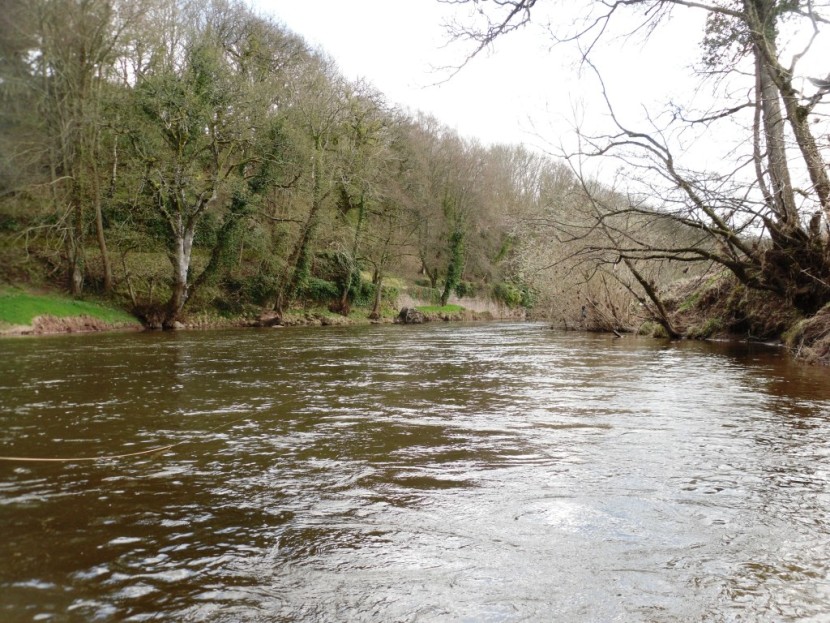 Ashford House
Ashford House 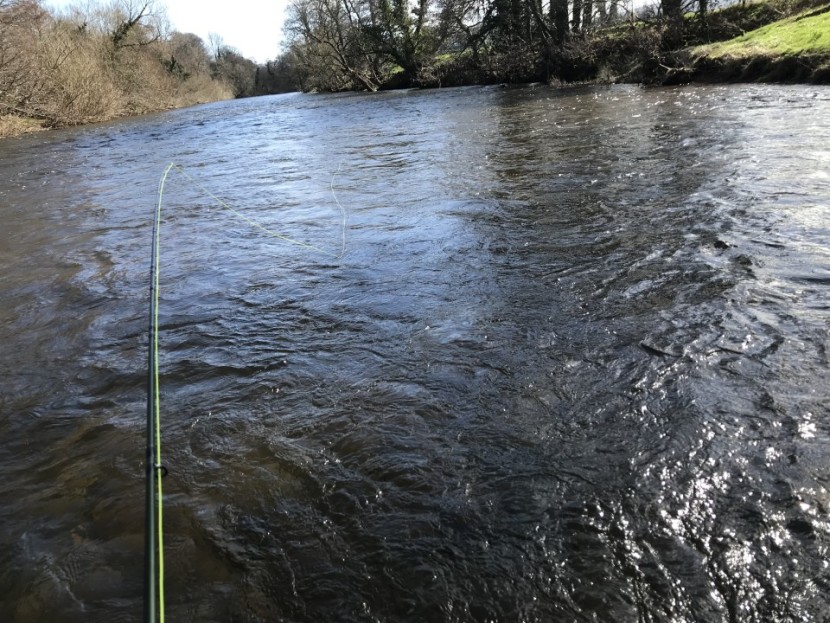 Abercynrig - DJ from Halesowen
Abercynrig - DJ from Halesowen Turning to the lakes, JO from Bristol had a fine pair of wild brown trout from Talybont reservoir, 15 and 16 inches. AR from Pontypridd with 3 friends only managed a brace of rainbow trout between them in difficult spring conditions on the reservoir at Llwyn On and once again we see the comment: “I don’t think they are stocking enough fish for the money they are charging.” I can only remind that this game of angling we are all so fond of can’t be compared to a slot machine into which you feed a certain fixed amount of money to get a bar of chocolate out from the bottom. The conditions on the day and skill of the angler will always define most of the story. On the 27th AP from Aberdare managed to take 5 trout from the bottom at Llwyn On, while on the following day TD from Llanwrda had 4 from the margins with a Mepps spoon before heavy rain came on. JF from Berriew also caught and returned 5 trout with a small single hooked Mepps on Aberystwyth AA’s Llyn Blaenmelindwr.
Meanwhile salmon anglers were still trying to come up with a first springer from the upper Wye, where the Llanstephan gauge remained stubbornly high at around 2ft 3 inches. MH from Swansea, a regular at the Rectory, had no joy with the double hander and turned to the trout rod to take 4 small trout on spiders. JC from Ilminster took 5 trout at Gromaine and Upper Llanstephan. Finally lower river gillie Nathan Jubb opened the Wye’s account on 22nd March with a 14 pounds fish from Whitney Court on the fly. Two days later another very fresh fish of 15 pounds was reported from Barry Paraskevas’ Usk beat at Chainbridge. Mamtas Mileus from Dudley saw the fish show below the bridge and it took on the second cast. On the 25th Jon Dawson took a 16.5 pounds hen from the Wye’s Golden Mile on a Black and yellow flying C. These sound like wonderful fish but no more to report at the time of writing.
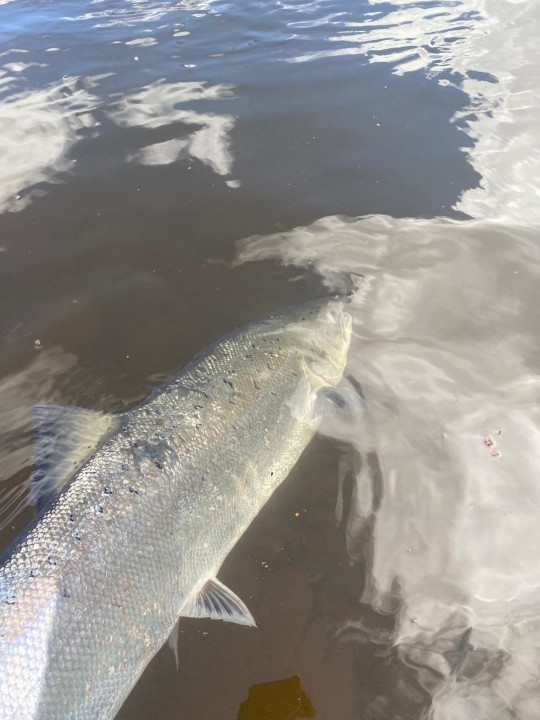 Chainbridge - MM from Dudley
Chainbridge - MM from Dudley 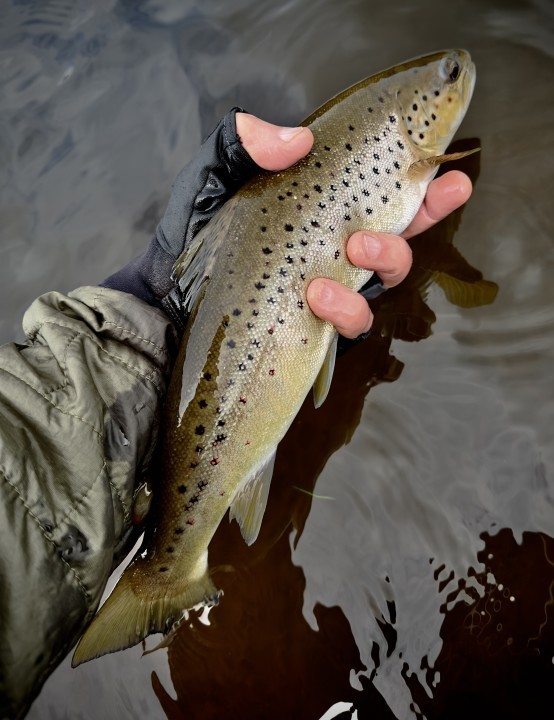 Talybont - JO from Bristol
Talybont - JO from Bristol The week leading into Easter was pretty frustrating for those of us trying to fish for trout in the Usk valley. A series of weather fronts continued to come in from the West, winds were strong and the sun was rarely seen. The temperature was low with snow on the surrounding hills. River conditions varied from high, to very difficult, to full flood and downright impossible. The land was absolutely saturated as some of us who tried to park in the usual river-side fields discovered. As a result, every fresh shower of rain and sleet which came over, having given us all a good soaking, went straight into the Usk. This is a river capable of rising and colouring very quickly. The amount of water falling on the Beacons is what counts and the head waters react very rapidly. Thus the upper river can rise or fall 6 inches or more in a day, and similarly colour or clear within a very short period. In these circumstances, it’s very difficult to calculate fishing bookings for guests along with some thought for people’s hotel bookings and holidays after travelling for hundreds of miles. On the 26th I was pleasantly surprised to have a great session fishing alone on the Breconshire Fishery. The river was high and air temperature low, but the rain held off for a while and fish were rising all along the stretch with one of the best blossoming hatches of large dark olives on a pool tail which I can remember. March browns were hatching round the corner. The river height then on the Brecon gauge was a very acceptable 1 foot 1 inch and the water hardly coloured. On the same day AH from Swansea had 5 trout with spiders and reported hatching March browns. Immediately downstream at Dinas IW from Pontyclun had 9 trout while upstream at Fenni Fach MD from Surbiton had 10 trout to 2.25 pounds on nymphs and a dry fly, again with a short hatch around 1 o’clock. MD had 8 trout from Ashford House using nymphs on the 27th. But a day with clients at Dinas on the 28th was a truly wet one, with the river coloured all day and in full flood by early afternoon. We recorded one trout and one “other,” the other being a poacher from neighbouring Abercynrig.
Turning away from the Usk for a moment, LT from Wantage sent in a report from the upper Wye’s Ty Newydd which is worth quoting in full. Note that the Wye was still flooding on the 27th when 2 trout and some out of season grayling were “caught by Jack Allen over from Canada with a broken wrist in a cast, a borrowed rod and only a pair of wellies: all from by Clettwr brook [outfall]. Proof that you don’t need all the gear if you know what you are doing. Jack was taught to fish by his grandfather, Bob Browning, who bought Ty Newydd in 1983.” I think I can remember talking about salmon fishing with Mr Browning on the terrace of what we used to call “the scout hut,” the wooden building which once stood overlooking the beat, which the family used for weekends and where we used to park. It’s a long story, but I also gave him a freshly shot duck for his barbecue if I remember correctly. Meanwhile SB from Stoke with a friend made an early attempt on the Teme at Bucknell, but without result. It was a good idea to try, though, on this beat which sometimes can produce big fish early in the season.
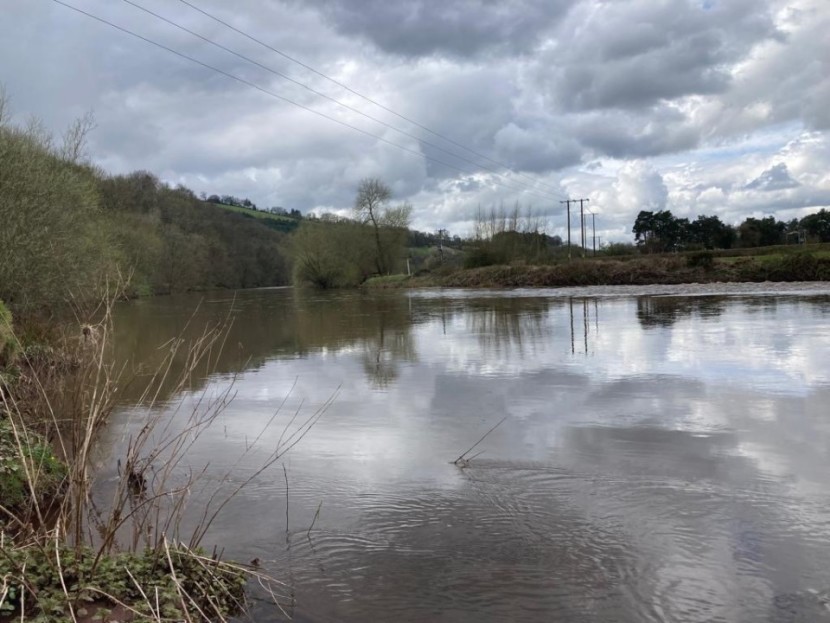 Dinas - AL from London
Dinas - AL from London 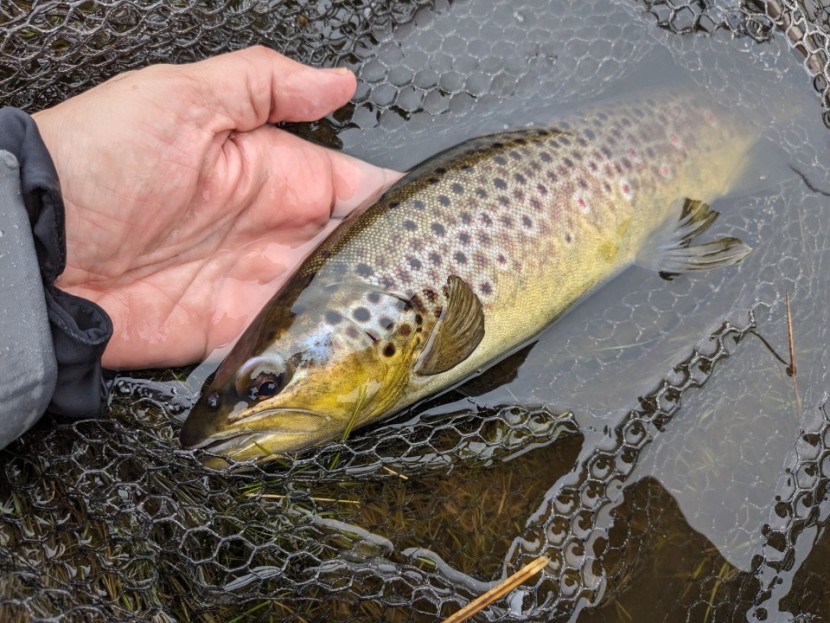 Llyn Egnant - CT from Cardiff
Llyn Egnant - CT from Cardiff And so into a difficult Easter holiday, with the main Wye in flood and the Usk in and out of flood, the Brecon gauge hopping up and down around 1 foot 6 inches. Personally I would regard 1ft 3 inches at Brecon as the practical maximum if the water is not too coloured; I try at 1ft 6 inches on occasions, but usually regret it. Many anglers were trying which is most creditable, although a large number were washed off and others blanked. Incidentally beware trying to cross a rising Usk; it’s easier to get caught out than you might think when the river is going up minute by minute. On Good Friday regular visitor AK from Churt tried some marginal fishing at Dinas and reported 1 trout and others lost during a short hatch. RG from Freshford with a friend had a better result up at Penpont with 15 trout taken on spiders. KN from Weston Rhyn complained that only about 10% of Upper Tower was fishable, which I am sure is true at these water heights. However, he did report 10 trout taken on this day. On the Saturday PR from Bristol had 11 trout at Abercynrig, 7 on nymphs and 4 on dry fly. In the cold and rain he saw a very few large dark olives plus a solitary stone fly. SP from London had a couple of days on the Colonel’s Water and Abernant on the Wye system, but each afternoon found himself warming up in the pub in Builth! AL from London with a friend had 7 trout from Dinas on Easter Monday, now with 1ft 6 inches on the gauge. They used spiders and nymphs. CE from Worcester had a 2.5 pounder in a brace taken at Dan y Parc where no fish were seen rising. RG from Freshford fished at Penpont again and reported 5 trout to 14 inches.
Plenty of anglers who could put up with the rain and wind did well on the mountain reservoirs over Easter. HD from Ammanford released 10 rainbows and a brown trout on the Usk Reservoir, using a Black and Green Damsel and an Orange Blob. AF from Swansea caught 7 on a Vibrax Minnow and a Humungous lure. GJ from Tredargar with two friends caught 10 rainbows at Llwyn On.
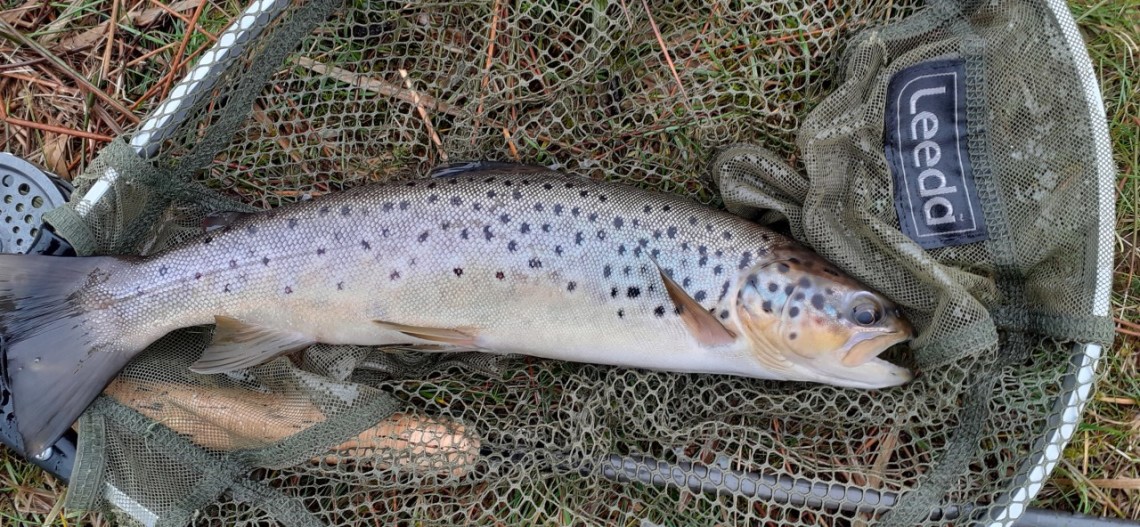 Llyn Teifi - JA from Rhayader
Llyn Teifi - JA from Rhayader Some dramatic photos of the effect of the floods were passed around the angling community during the Easter weekend. Chalk streams were not immune. In the Avon valley the river was out of its bed and over the water meadows, even pouring into stew ponds to spread baby trout far and wide. The Loughor at Pontardulais, always a free ranging river running as it does through sandy meadows, chose this time to cut through several bends. You can see these changes coming over several years, but when the river finally undermines the last cliff and the built up layers of silt collapse, it does so quickly. You are left with a new pool or run to learn and an ox-bow lake which will over time turn into a swamp beloved of water birds and frogs, and finish as a mere depression in the grass which will remain perhaps for centuries until the river switches direction yet again.
March saw demonstrations by Welsh farmers expressing unhappiness with the new Sustainable Farming Scheme, which is essentially a financial encouragement to ensure a percentage of land is reserved for trees and other environment enhancing measures, rather than being devoted to pure food production. Farmers all over Europe seem to be unhappy at the moment, although the prize for explicit demonstration of dissatisfaction must as always go to the French. It’s interesting to read Afonydd Cymru discussing the SFS project and asking: “…will it achieve clean, healthy rivers in Wales?” Alone in itself, probably not, seems to be the answer. There is an article on this subject on their website along with Afonydd Cymru’s position statement. I would also like to quote Afonydd Cymru on Natural Resources Wales’ long-standing insistence in relying on “light touch” regulation:
“When it comes to pollution, for too long we have heard the mantra “prosecution is a sign of regulatory failure.” Almost everyone else believes that pollution is the sign of regulatory failure.”
Across the border, a public discussion on the mess which the Thames Water Co has created for us since privatisation ensures that the sorry state of our English rivers are once again under national attention. Thames Water is an extreme and very large example of this problem, already involving a sad history of prosecutions for pollution. However Thames is not unique in demonstrating the dangers of a monopoly in which the need for investment and protection of a natural resource play second fiddle to rewarding shareholders and management. Under these circumstances, fines need to be enormous in order to produce a change in behaviour. More cases involving other companies will probably follow. Right now the argument is about where the funds will come from to correct the failures of the last 40 years in the Thames catchment. If Thames is now to make the investments they should have made, there will be a 15 billion pounds black hole in the accounts. Thames management are suggesting increasing customers’ bills by 40% to take up the slack. OFWAT, showing some teeth at last, is determined it should not come from higher bills for consumers. The shareholders, who have done well thus far, clearly are not going to put any more money in. Michael Gove sensed the public mood and led the charge with a scathing speech accusing the Thames leadership of arrogance and “serial mismanagement.” Again, “It’s down to Brexit,” somebody declared to me the other day. Not at all, the problem has been building for decades. It’s a matter of privatisation and how to ensure responsible future investment when you hand a monopoly over to share-holders who allow managers to over-pay themselves. Some suggest just allowing Thames Water to fall into administration. I’m becoming a convert to the idea of re-nationalisation in the case of the water and other strategic industries, but that will involve tax-payers picking up the tab for the clean-up.
Port Talbot isn’t a town I know well. Like other motorists I normally do no more than look down while passing along the M4 embankment above what must have once been an area of desolate sand dunes between the mountains and the sea. From the motorway today I get a general impression of railway lines and sidings, terraced houses with slate roofs and of course the great factories, the oxygen and steel plants. There are 30,000 people living here and the steel works is a giant, supposedly one of the biggest in Europe, and comparable with Bosnia’s Zenica.
I know that for some reason this town also produces actors: Richard Burton, Anthony Hopkins, Michael Sheen, Bernard Fox and my son’s friend Rob Brydon to name but a few. On a couple of occasions I have stopped off to fish Eglys Nunydd reservoir, which, perhaps as the sea is not far away, looks at first glance like a saline cooling pond for the industry lying behind it. Actually cooling was indeed its original purpose, but this concrete lined body of water is not salt at all, but fresh and alkaline, surprisingly fertile with good hatches of fly, particularly caddis. The steel company Tata runs the angling club.
During those summer evenings and nights when I fished the Loughor and Towy frequently for sewin, I used to pass Port Talbot regularly on my way to and from Carmarthenshire. Travelling west, Port Talbot would be mainly an opportunity to get involved in a traffic jam as people left work. I didn’t mind too much, provided I could reach the river and set up by dusk. The home run was different, assuming I didn’t fish right through to dawn. Instead, if I was running for home in Gloucestershire at 3 or 4 in the morning, there would be a choice between taking the Heads of the Valleys road by Neath and cutting across the mountains towards Abergavenny and Monmouth, or following the motorway round the curve of South Wales to Newport and Chepstow. The first choice was a good one if I was feeling sleepy, because changing down for the numerous roundabouts on the inland road would keep me awake. But the motorway, while it is longer by a few miles, is usually the faster route. After crossing the estuary by Port Neath, I would round a corner to come across Port Talbot steel works as a vision of fire and smoke. The sight was never exactly the same, depending on the darkness or the dawn mists, but if that fiery plume was streaming into the sky from the stack it all looked as dramatic as a Turner painting. In fact I used to imagine that the more fire and smoke drifting downwind the better, as a visible sign of money being made. Through most of my lifetime the steel works has been almost continually under the threat of closure or reduction. It has been feared for many years, but now it is probably going to happen.
Last month, we heard that something like the end might really be coming to this famous plant, remnant of a once-great industry. Indian owner Tata Steel’s plan is to shut down the two existing coal-fired blast furnaces and replace them with a single electric arc furnace. This will produce a greener operation, with a reduction of 1.5% in the UK’s overall carbon emissions. Tata originally threatened to close the whole plant, but the UK government has chipped in with 500 million pounds of our taxes in order to persuade them to keep it running on electric arc. The electric arc furnace system is less labour intensive, so right away there go 3,000 jobs boys. Even more importantly, electric furnaces cannot make virgin steel from iron ore, but instead rely on recycling scrap steel and produce a lower quality product. That would make the UK the only G20 nation incapable of making its own virgin and high quality steel from ore. For our defence industry in particular, for ship-building, for railways and many other activities, we will in future have to import the good stuff. Rather like the water industry, from a UK strategic point of view, that concerns me greatly. It strikes me as one of those dubious decisions equivalent to that made by Germany, whose leaders decided a few years back to rely on Russian gas because it was the cheapest option at the time. As we all know by now, that decision did not serve Germany well.
 copy.jpg?w=1140) The beach at Port Talbot
The beach at Port Talbot Now and then, usually on a Wednesday night, I meet up with fishing friends Lyn and Rob in the Black Horse, where we sit before glasses of Reverend James in the parlour. Apart from wondering what happened to the sewin run, there’s plenty to catch up on with the doings of various other fishing friends who rarely are known in town by their birth given names. What is the news from the likes of Big Mark, Mad Mike and Lenny the Licence? My two friends work in Swansea, Lyn with the DVLA and Rob as a printer, although Lyn lives in Pontardulais at the head of the estuary of the Loughor and Rob by the sea at The Mumbles on the road to the Gower. Along with the fishing talk, the obscure history of local fishing rights, canny land agents, eccentric farmers and apparently even more eccentric rural solicitors, there are usually stories of poachers and of course water bailiffs. Rob, who has a bit of an eye for local history, likes to remind me on occasions that this is after all Dylan Thomas country. It still feels like it at times. Here’s something for fans of the Welsh writer and poet. I came across this written by Leslie Norris in an introduction to a collection of the great man’s short stories:
“Some years ago, John Ormond, distinguished film-maker, friend of Dylan Thomas and himself a poet, was shooting a film in West Wales. I was involved in this programme and was to go down to the Teifi river, very photogenic in spate, and cast a line into the water. This was strictly illegal, the fishing season having closed, but we cleared this by getting permission from the agent of the estate through which the stretch of water ran. It would be fine, he said, as long as I didn’t put a lure on my line. Dressed in my fishing garb, I stood on the rocks above a foam of water and cast my harmless line. The cameras rolled. For about five minutes. Then the river bailiff appeared, large and implacable.
“What’s this?” he said.
“I’m pretending to fish,” I said, “so that these men can make a film.”
“Not allowed,” he said, “the river’s closed.”
“We’ve seen the agent,” I said.
“You may have,” he said, “but I’m the river bailiff and I say you stop now.”
“For God’s sake,” I said, “I’m only pretending.”
“So you say,” he said.
“Look,” I said, reeling in my line, “I don’t have a hook on. What do you think I’m going to do, lasso the fish?”
“You might,” he said darkly.
The ghost of Dylan Thomas, I felt, was not far away.”
That’s all to report for this month. Would it be too much to ask for some dry days in April and perhaps a bit of sunshine? Tight lines!
Oliver Burch